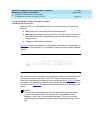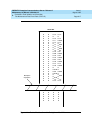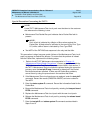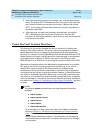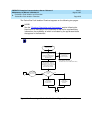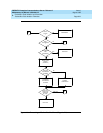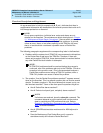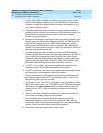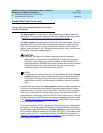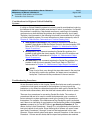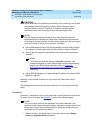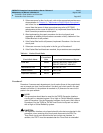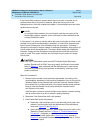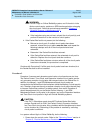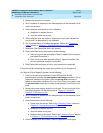
DEFINITY Enterprise Communications Server Release 6
Maintenance for R6vs/si
555-230-127
Issue 1
August 1997
Packet Bus Fault Isolation and Correction
Page 9-23Packet Bus Fault Isolation Flowchart
9
c. If only a single EPN is affected, the Packet Control is probably not the
source of the problem. However, if all of the ISDN-BRI circuit packs are
located in a single EPN, assume that the answer to this question is ‘‘No,’’
and check the Packet Control.
d. A Packet problem that affects more than one port network is probably
caused by either a Packet Control failure or a PPN Packet Bus failure. The
Packet Control is checked before the Packet Bus Fault Correction
procedures are implemented.
e. Because the Packet Bus in each port network is physically separate, each
affected port network must be checked individually. The PPN should be
checked first, however, since any EPN Packet problems are usually
resolved once the PPN Packet problem is resolved. After resolving the
problem in one port network, be sure to check if the problems in other port
networks have also been resolved.
f. This step applies only when an attempt to resolve an EPN Packet Bus
problem is made. When checking the Expansion Interfaces in an EPN, be
sure to check the corresponding ones in the PPN. Also, recall that all
Expansion Interfaces in 286 systems, 386 systems, or later systems that
are using the Packet Bus must be TN570s. Using TN776s results in an
EPN where TDM traffic works but Packet traffic does not work.
g. If a TN771 is not present, one must be installed to accommodate the
standalone mode, which is discussed earlier in this chapter.
h. If a TN771 is present, it can fail in such a fashion that it eventually disrupts
the Packet Bus or misinterprets a Packet Bus problem.
i. If work is being done on-site, follow the procedures described earlier in
this chapter for placing the TN771 into standalone mode. If work is not
being done on-site, go to the next step.
j. The answer is ‘‘Yes’’ if the TN771 in standalone mode indicates any faulty
leads. The answer is also ‘‘Yes’’ if Test #572 in the PKT-BUS test sequence
fails, and/or if the status system display indicates that faulty leads are
present and the TN771 in the port network is known to be functioning
correctly.
k. If the non-functional endpoints are isolated to a single circuit pack, the
circuit pack is probably the cause of the problem.
l. The procedures that must be executed are determined by which
maintenance objects on the circuit packs are alarmed. Start with the
procedures for the circuit pack errors/alarms, then continue with those for
the port. Finally, execute the procedures for the endpoint.
m. Follow the procedures outlined later in this chapter.



